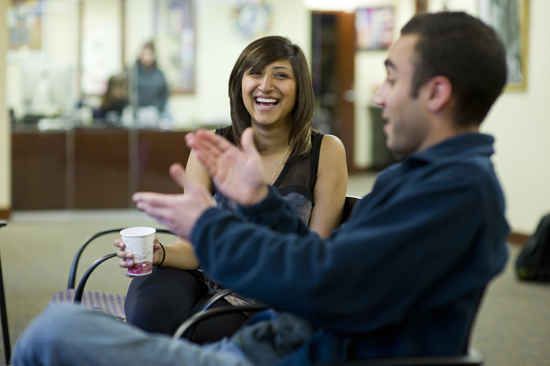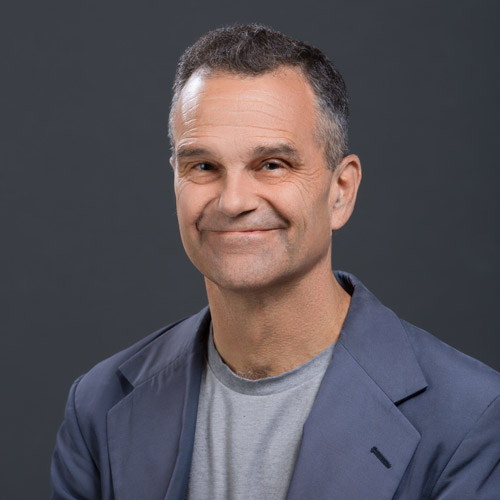The Thurman Center: Evolving with Students
How to succeed in diversity

The Howard Thurman Center hosted its weekly tea party the other day. No, this wasn’t the kind that draws Sarah Palin devotees; this one was designed for fans of Egyptian chamomile and halawa confections of sesame and sugar.
For the less adventuresome, Annie Rupani (CAS’11), who organizes the Tea Club, provided bags of Lipton and Tetley in wood-and-glass cases on the crimson-clothed table. Tea-lovers lingered to chat at the table or lounged in the comfortable chairs and sofas in the center’s GSU basement lounge.
Sipping tea like a country squire isn’t the first thing that springs to mind when you think about a place dedicated to cultural programs. Yet the Tea Club lured a cross section of students this day—from Tino Henrik Bratbo (CAS’13), a white New Jerseyan by way of Denmark, to African American Kimberly Morton (CAS’11) to Rupani, an olive-skinned Texan of Pakistani ancestry. In the words of Thurman Center assistant director Raul Fernandez (COM’00), the year-old club draws a group that’s “diverse without even trying.”
This year marks the 25th anniversary of the center, founded to offer cultural programs that carry on the multicultural, barriers-busting philosophy of the late Marsh Chapel Dean Howard Thurman (Hon.’67). Observing the milestone, the Thurman Center is evolving a new strategy to fulfill that mission. It is morphing beyond what Fernandez says was a place where only students of color came. “From our perspective, we were always for the entire campus,” he says. “But we weren’t reaching the whole campus. We wanted to be something broader.”
Director Katherine Kennedy agrees: “Our programs have always been inclusive.” The center fashioned new events to make itself a hub where students of all races and ethnicities engage in shared passions that aren’t particular to any one group. That might be tea. Or it might be the center’s Book Club, or its Culture Shock blog for aspiring writers, both launched within the past few years. Walk in on these activities, Fernandez says, and you see “a little bit of a Times Square. The most diverse events that we’ve had here have been events that had nothing to do with what you look like. Book Club—all you’ve got to do is be able to read. Tea Club—obviously, you like tea. If you don’t like tea, you can still show up. I’ll serve some coffee.”
More events have meant more attendance, which increased from about 6,000 visits in 2007 to more than 21,000 last year.
Fernandez argues that the emphasis on cross-culture activities keeps faith with the philosophy of the center’s namesake. In 1944, Thurman cofounded the Church for the Fellowship of All Peoples in San Francisco, America’s first integrated, nondenominational congregation, drawn together by a common spirituality that knew no racial or creedal distinctions. “His intent was to connect people,” says Fernandez. “He said there was something called common ground, and if people can find that, whatever it is—some people find common ground around bad movies, or anime—then they can understand one another better.”
Thurman unwittingly forecast the attitudes of many 21st-century BU students, who either don’t identify themselves primarily by race or ethnicity or else are more interested in comparing notes with peers of different backgrounds.
“I identify myself more by my experiences. You don’t choose your culture. Your experiences are something you shape about yourself,” says Jennifer Gilbert (CAS’14), who is Jewish
“My identity’s still a work in progress,” says Bratbo. “I don’t really identify by my culture or demographics. If anything, I identify with the Howard Thurman Center,” as a student ambassador, or volunteer.
Both Bratbo and Gilbert are part of the nation’s white racial majority, and race can be more crucial to minorities. But Morton and Alexandria “Sandy” Ocasio-Cortez (CAS’11), for whom ancestry is a point of pride and essential to their sense of self, also value the chance to mingle with others from different backgrounds.
“I am black Baptist. That’s not something I’ve lost at the Thurman Center,” says Morton. “Raul’s correct; this center used to be very visited by students of color, and it still is. You find that common ground—which for all of us is tea—and we might have a conversation and I’ll say, ‘Oh, Tino, you’re from Denmark, that’s interesting,’ and talk about Danish culture. It’s still a cultural center, but it’s definitely more than that.”
Ocasio-Cortez, also an ambassador, stresses her Hispanic identity and Puerto Rican family. But Thurman’s writings urge readers “to act in accordance with your passion,” she says. “Some people are passionate about their cultural heritage, but some are passionate about other things that happen to have a cultural breadth—tea being one of them.”
“One of the things that allows people to expand who they are is to identify with other people’s passions. I identify with my cultural community, but I’ve learned a lot from Tino’s passion for literature.” (Did we mention the Thurman Center has a Book Club?)
You’ll still see racially or ethnically focused groups meeting at the center, from Alianza Latina to the Russian American Culture Club. Cultural identity is especially important to students of color, says Kennedy—hence the center’s affiliated cultural groups. But “we work to make sure that is not all they focus on, by encouraging them to find that comfort zone” through other center activities.
Besides, says Fernandez, there’s only so much the Thurman Center can do to help cultural groups express themselves: “I can’t tell somebody what it means to be Russian.”
The Thurman Center is open to all students. Watch a video with more information on the center’s mission here.
Read part one, “Who Was Howard Thurman?” here.
Rich Barlow can be reached at barlowr@bu.edu.

Comments & Discussion
Boston University moderates comments to facilitate an informed, substantive, civil conversation. Abusive, profane, self-promotional, misleading, incoherent or off-topic comments will be rejected. Moderators are staffed during regular business hours (EST) and can only accept comments written in English. Statistics or facts must include a citation or a link to the citation.